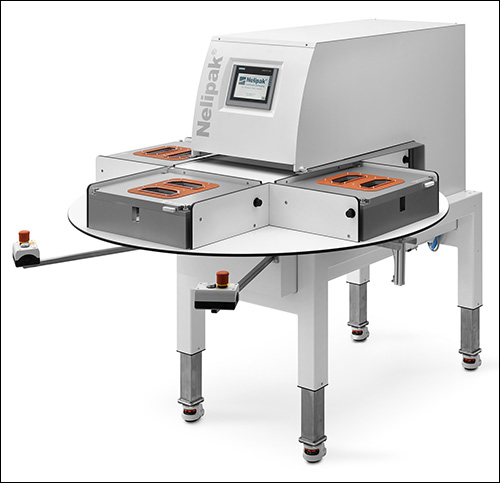Global health-care packaging company Nelipak provides thermo-formed packaging that has been used in the medical device and pharmaceutical industry for more than 60 years. The company also offers sealing machinery that can be utilized along with Nelipak’s products to seal up a medical or drug-delivery device that is being packaged.
During the past few years, Nelipak has added RFID and other functionalities to its tray-sealing machine range, in order to provide greater control for users. This month, the company released the latest version of the system, known as the NX-B 4-station rotary—a free-standing tray and blister lid sealer that employs passive HF RFID technology to ensure that the components used in the sealing machine match the requirements for that particular package and product.
Nelipak, headquartered in Cranston, R.I., operates eight packaging manufacturing locations, with approximately 1,100 of its machines currently in operation by customers throughout Europe and North America. “Our core business is clean room packaging for the health-care and pharmaceutical markets,” says Sean Egan, Nelipak’s global marketing director. Companies that utilize Nelipak’s packaging and sealing technology make products such as catheters, implantable orthopedic devices and oncology medications. Controlling the packaging of such items is imperative, the firm explains, since regulatory bodies need to see proof that each product was packed within specifications prior to sterilization, and that it is properly sealed before a patient receives it.
Each package can have its own requirements in terms of the heat, pressure and amount of time involved in the application and heating of a sealant, to ensure a proper lid seal without affecting the quality of the product inside. The company refers to these specifications as each product’s “recipe.” To ensure that mistakes are not made, regulatory bodies seek records of each sealing process parameters. “It’s important to provide evidence to regulatory bodies about the components used” during each sealing process, says Bert Verheugen, Nelipak’s VP of technical support.
When the company began planning a next generation of its sealer equipment leveraging technological improvements, Egan says, it invited input from its customers. Those customers indicated that they wanted better control of the process, in order to ensure that only authorized individuals could adjust settings or change parameters, or simply operate the equipment. It also wanted a way to ensure that the proper tooling and recipe were always used for each product and type of packaging.
Nelipak supplied a six-level password functionality to provide specific levels of access to users for its new cleanroom-compatible device, as well as RFID technology to control which toolsets were being utilized with any given recipe. A user first inputs a password to enable the machinery to proceed through the sealing process, then enters product information and selects the related recipe of time, temperature and pressure for the sealing process defined in a product’s specific recipe. The machine has a built-in processor that can store up to 20 recipes at a time. The user then places the tray, lids and packaged products in the machine and activates the sealing cycle.
Depending on the recipe, different heating plates and sealing dies are required, and employees must change those manually to suit specific processes. The sealing die holds the package in place, while the plate applies heat and pressure to the lid as it is applied to the package. Each plate and die comes with an RFID transponder, Verheugen explains, which is bolted in place with a unique ID number encoded on it.
The machine itself includes 13.56 MHz HF RFID read-write heads that will come in contact with the die or plate transponder once the machine is set for operation. A read-write head interrogates a tag on a die or plate, receives that tag’s unique ID number and forwards the collected data to a gateway—and, ultimately, to the processor built into the machine.
If the machine determines that the recipe does not match the components, it will lock the system, making it impossible for the sealing process to take place. In the event that a component is determined to be missing, or if a part is not loaded properly, the tag will not be interrogated. The system will thus not operate, and will indicate what the issue is. This is important, Verheugen says, because trying to seal a package with the incorrect tool or recipe combination, or with it improperly mounted, could lead to a seal being ineffective, and could also damage the component or package.
If the proper recipe and tool combination is fitted correctly, the machine is ready to seal the lid onto the package. Its built-in processor stores that action for the company’s own records, as well as to provide information to regulatory bodies when so requested. Some machines require as many as four sealing dies; in such a scenario, each one comes with its own RFID tag and reader to capture the presence of each die.
The next steps, Egan says, will be to release a cloud-based service to capture the data related to each process, and to store that information automatically on a server that users can then access. That is expected to occur this summer, he reports. Until then, the system will store the data internally, and a thumb drive can be used to access that data and upload it onto a user’s own software-management system.
The machine also comes with features to ensure that packaging is not mishandled. For instance, it can make sure blister packs are never gripped from the wrong edge, and that an auto-ejector is instead utilized to pop each blister free from the machine, thus enabling an operator to remove the tray without straining the still-hot seal.



